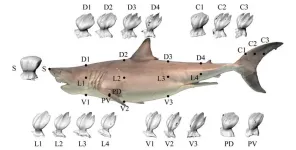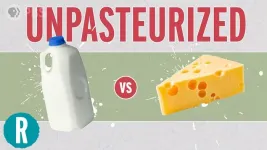(Press-News.org) COLUMBUS, Ohio – A new study is the first to shed light on the high prevalence of head injuries, and related mental health symptoms, in a previously overlooked population when it comes to concussion surveillance: law enforcement officers.
The survey of Ohio law enforcement officers found that 74% reported a lifetime history of one or more head injuries, and 30% had a head injury that happened on the job. Many more of these injuries went unreported than were treated by a health care professional. And further analysis showed post-traumatic stress disorder and depressive symptoms were higher in those who had experienced one or more head injuries.
“This is an area where we have to improve awareness, just like we did in the sport concussion world,” said lead author Jaclyn Caccese, PhD, assistant professor in the School of Health and Rehabilitation Sciences at The Ohio State University Wexner Medical Center.
“The goal is really to improve officer safety and health in the long term,” said Caccese, also an investigator in Ohio State’s Chronic Brain Injury Program. “And I think there’s a lot of potential there, especially when it comes to improving career longevity – that although treating these injuries is difficult in the moment, it leads to a longer career, better health outcomes and better quality of life, not only in their service, but also in retirement. I think with that awareness, they will be more likely to report injuries as they sustain them.”
The study is published today (Aug. 5, 2024) in the Journal of Head Trauma Rehabilitation.
The medical and law enforcement researchers who co-authored the study have published a separate paper advocating for implementation of a concussion return-to-duty protocol for law enforcement officers – similar to practices already in place in sports and the military.
The researchers surveyed 381 law enforcement personnel in central Ohio about their lifetime head injury history, years of service in the military and civilian law enforcement, and rank and section assignment (such as patrol, corrections or administration). The participants also completed questionnaires assessing symptoms of PTSD and depression.
Of those respondents, 282 reported one or more prior head injuries, mostly from sports, followed by such incidents as falling or being hit by something or someone, a car accident, or exposure to a blast. Over 50% of participants reported head injuries involving loss of consciousness or followed by feeling dazed or confused, or having a gap in memory – all signs of a probable traumatic brain injury (TBI). A concussion is considered a mild TBI.
Nine percent of total respondents screened positive for PTSD symptoms and 36% reported mild or greater depressive symptoms. Participants with a prior head injury reported higher symptoms for both conditions. Researchers estimated that fewer than 1 in 4 head injuries was diagnosed or treated by a health care provider.
Caccese said researchers are still learning about the long-term effects of concussions, but current evidence suggests head injuries that go untreated may increase risk for depression, anxiety, PTSD and problems with cognitive function and memory.
For law enforcement officers, concussions often occur in the heat of their job. The stress associated with the role and poor sleep from shift work are also common in this population. The circumstances can contribute to worse outcomes following a head injury.
“Sometimes law enforcement officers need to complete the task they’ve set out to do, or it’s not a safe environment to just pull yourself off duty right away. And I think adrenaline sometimes masks concussion symptoms,” Caccese said. “In sports, we’ve been able to increase removal from play, and improve rehabilitation and return-to-play following injury. Hopefully that will improve long-term health outcomes in athletes. We’re trying to get that information translated to the occupational context.”
Study co-author Josh Walters, a deputy in the Franklin County, Ohio, Sheriff’s Office, leads his office’s peer support team of deputies certified to work with personnel experiencing a range of problems. Teaming up for the study of head injuries and their association with PTSD and depressive symptoms grew out of the peer group’s long-term partnership with Ohio State researchers and clinicians to enhance deputy health with physical therapy, sleep studies and concussion-related training.
“Part of what we’re doing with Ohio State is looking at, how can we extend the health of the deputy?” Walters said. “Being physically fit is an important part of our job because not only do my colleagues depend on me, but the community depends on me. And if I can’t physically keep up, then it could be a life-or-death situation for somebody.”
The next step is working to adopt the return-to-duty protocol proposed by the team – removal from duty, a gradual increase in activity, and screening by a medical provider before returning to full duty – and testing its effectiveness and adaptability to different organizations.
“Now we have some data that we can present to administrations, to unions, to leadership that says, ‘Here’s the problem. This is how we can fix it. Let’s start working that process,’” Walters said.
Additional co-authors are Carly Smith, Nathan Edwards, Angela Emerson, Enora Le Flao, Jeffrey Wing, Joshua Hagen and James Onate of Ohio State and Scott Paur of the Franklin County Sheriff’s Office.
This work was supported by the Assistant Secretary of Defense for Health Affairs endorsed by the Department of Defense, through the Traumatic Brain Injury and Psychological Health Research Program under Award No. HT9425-23-1-0520 and HT9425-23-1-0521. Opinions, interpretations, conclusions and recommendations are those of the author and are not necessarily endorsed by the Department of Defense.
#
Contact:
Jaclyn Caccese, Jaclyn.Caccese@osumc.edu
Written by Emily Caldwell, Caldwell.151@osu.edu; 614-292-8152
END
A new national multicenter study offers hope for women who have undergone allogeneic hematopoietic cell transplantation (alloHCT). The results of the study, recently published in the renowned journal Blood, show that successful pregnancies are possible under certain conditions, especially in younger women, patients with non-malignant diseases, and those who received no or only low doses of total body irradiation (TBI).
For many benign hematologic disorders, allogeneic hematopoietic cell transplantation (alloHCT) is the only ...
LEXINGTON, Ky. (Aug. 2, 2024) – The University of Kentucky’s Sanders-Brown Center on Aging has introduced a groundbreaking initiative, Brain Health Activities, aimed at supporting individuals with dementia and their caregivers. The program was developed with extensive collaboration across the UK campus, offering a variety of resources designed to enhance brain health and quality of life for those affected by dementia and their caregivers.
The idea for ...
New findings on how sharks achieve drag reduction could inspire the design of riblets for more efficient aircraft and boats. In their investigation of great white shark denticles, researchers from Tokyo Tech found that ridge height and spacing play crucial roles in drag reduction at different swimming speeds. Higher middle ridges aid sharks in efficient cruising at slower speeds, while the lower side ridges become more critical for drag reduction during high-speed hunting bursts. The analysis also suggests that the speeds of an extinct giant ...
A first-of-its kind study conducted in Canada’s two largest cities by McGill-led researchers has linked about 1,100 premature deaths per year to an unregulated air pollutant.
Ultrafine particles (UFPs) primarily come from vehicle emissions and industrial activities. Canada’s federal and provincial governments have not set concentration limits for UFPs, as they have for larger fine particles known as PM2.5.
“Ultrafine particles are incredibly small, allowing them to penetrate deep into the lungs and enter the bloodstream. Increasing evidence suggests these pollutants may contribute to heart and lung diseases, as well as certain forms of cancer,” ...
Four researchers from the Institute of Photonics at Leibniz University Hannover have developed a new transmitter-receiver concept for transmitting entangled photons over an optical fiber. This breakthrough could enable the next generation of telecommunications technology, the quantum Internet, to be routed via optical fibers. The quantum Internet promises eavesdropping-proof encryption methods that even future quantum computers cannot decrypt, ensuring the security of critical infrastructure.
"To make the quantum Internet a reality, we need to transmit entangled photons via fiber optic networks,” says Prof. Dr. Michael Kues, Head of the Institute ...
WASHINGTON, Aug. 5, 2024 — A lot of people on the internet have been telling our host Alex to drink raw milk. This is a bad idea — a particularly bad one actually. So she wanted to make a video about why it’s such a bad idea to consume raw milk, then she realized she’s been eating raw milk without even knowing it via cheese. That’s when things got complicated.
Reactions is a video series produced by the American Chemical Society and PBS Digital Studios. Subscribe to Reactions and follow us on X, formerly Twitter @ACSReactions.
The American Chemical Society ...
DALLAS (SMU) – It’s a relevant question for business owners with few repeat customers, such as contract workers or real estate agents: Does being transparent about past business transactions change the odds of making a sale that benefits both buyer and seller?
The answer matters because mutually beneficial sales ensure that these kinds of transactions will continue, keeping the economy strong.
A new study published in the journal American Economic Review suggests the answer depends on a variety of factors.
A mutually beneficial sale is defined from two points of view: The seller values the money they receive more than ...
(Denver, Colo.—August 5, 2024) – Lung cancer remains the leading cause of cancer-related deaths worldwide. Detecting this disease in its early stages significantly improves survival rates, making low-dose CT screening an essential component in the fight against lung cancer. Recent studies, particularly from Asia, have sparked a debate on whether these screening benefits extend to non-smokers and those with minimal smoking histories.
However, according to an article published in the Journal of Thoracic Oncology, there is currently insufficient evidence to support ...
About The Study: The findings of this study show small to moderate effect sizes that highlight the need to consider screen use contexts (i.e., type, content, co-use, and purpose of use) when making recommendations for families, clinicians, and educators beyond screen time limits; including encouraging intentional and productive screen use, age-appropriate content, and co-use with caregivers.
Corresponding Author: To contact the corresponding author, Sumudu Mallawaarachchi, PhD, email sumudu@uow.edu.au.
To access the embargoed study: Visit our For The Media website at this link https://media.jamanetwork.com/
(doi:10.1001/jamapediatrics.2024.2620)
Editor’s ...
About The Study: In this cross-sectional study of 13,000 pediatric emergency department visits at nine university hospitals in Italy, school opening following a COVID-19 pandemic–related school disruption was associated with an increase in acute psychiatric emergencies. The findings of this study suggest that school may be a major source of stress for youths; factors mediating school-associated mental health disturbances in youth should be investigated.
Corresponding Author: To contact the corresponding author, Benedetto Vitiello, ...





